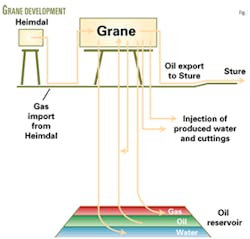Gas, water injection included in off-Norway heavy-oil development
To realize a much better recovery factor, Norsk Hydro ASA selected pressure maintenance with gas and water rather than water alone for developing the heavy-oil (19° gravity) Grane field in North Sea Block 25/11, off Norway. Fig. 1 illustrates the development scheme.
With estimated recoverable reserves of 704 million bbl of oil, Grane is the largest known oil discovery on the Norwegian shelf that remains undeveloped, according to Norsk Hydro. It estimates that the field will reach a peak 214,000 bo/d production plateau during 2004-10, with first oil expected in October 2003.
Owners in the field include Norsk Hydro (operator), 38%; Petoro AS, 30%; Esso Exploration & Production Norway AS, 25.6%; and Norske Conoco AS, 6.4%.
Grane field
Since discovery of Grane in 1991, Norsk Hydro has completed extensive studies to determine methods for recovering oil from the field that has only a few features in common with other fields on the Norwegian shelf.
Most fields on the shelf have lighter oil in thin Jurassic reservoirs, while Grane has low-pressure, viscous heavy oil in Tertiary sandstones at a relatively shallow 1,700-m depth. In Grane, the oil column has an 80-m maximum thickness and a low 83 scf/bbl producing GOR.
Norsk Hydro expects to recover about 55% of the original oil in place from the very permeable, 1-12 Darcy, poorly consolidated, turbidite sandstone with an areal extent of about 6,700 acres. Reservoir porosity is 33% and reservoir temperature and pressure are about 170° F. and 2,550 psi, respectively.
At one time Norsk Hydro had planned the Grane development to include carbon dioxide sequestration (OGJ, Oct. 19, 1998, p. 85). That plan would have involved first generating CO2 and hydrogen from natural gas onshore before injecting supercritical CO2 in the Grane reservoirs to improve oil recovery while using the hydrogen to fuel onshore gas-fired power plants that used steam reforming to convert natural gas to hydrogen and carbon monoxide. In the process, water also combines with carbon monoxide to form CO2 and hydrogen.
At that time, Norsk Hydro estimated that burning hydrogen in power plants reduces CO2 emissions by 90% compared with conventional gas-fired power plants.
Offshore platform
The Grane development calls for installing a steel jacket, integrated quarters, processing, and drilling platform in April and June 2003. The platform, designed for a 30-year life, will be set in 128 m of water, about 185 km west of Stavanger.
Platform dimensions are 99.5-m total length, 27.5-m maximum width, 45-m topsides height, and 150-m jacket height.
Its 10,700-tonne production module is designed to handle 34,000 cu m of oil (214,000 bo/d), 19,000 cu m/day of injected water, and 10 million cu m/d of gas injection.
The platform will have a 300-tonne flare system, 4,200-tonne power generator module, 6,000-tonne drilling module, 18,000-tonne jacket, and 1,200-tonne living quarters to accommodate 130 persons.
Wells
The development plans include drilling 35 wells, of which 27 are for producing oil. Sapeim SPA's Scarabeo 6 semisubmersible rig is predrilling 9 producing and 2 gas injection wells. The remaining wells will be drilled from the Grane platform.
The predrilling uses water-based mud and cutting reinjection.
Norsk Hydro indicates that to ensure maximum production efficiency, the wells will be drilled 9 m above the oil-water interface.
To achieve this drilling precision, it developed in conjunction with Schlumberger Oilfield Services an ultradeep resistivity tool to measure the distance to the oil-water interface during drilling. It also conducts seismic surveys while drilling that allow it to look 300-400 m ahead of the drill-bit.
Grane will have three water-injection wells for reservoir pressure maintenance. The plan includes reinjecting produced water in the oil reservoir and also into the Utsira formation at about 1,000 m below the seabed.
Also, after 15 years of production, Norsk Hydro expects to drill a water production well in the Utsira to provide additional water for maintaining reservoir pressure.
For pressure maintenance, Norsk Hydro also will inject natural gas in three wells. Because Grane reservoirs have a limited amount of initial gas, the first phase of the development calls for importing supplemental gas from the Heimdal gas center through an 18-in., 50 km pipeline laid in Summer 2002.
The gas also will be used for operating the generators and compressors on the platform.
During the second phase of the development, Norsk Hydro expects the field to produce sufficient gas so that importing gas will become unnecessary. The field also may have a third phase during which gas may be recovered for sale.
To increase oil producing rates, Norsk Hydro plans to produce the wells with gas lift, with the gas being injected in the wells at 1,600 m below sea level.
Crude export
Norsk Hydro will export Grane oil through a 28 in., 212-km pipeline to the Sture terminal north of Bergen. It laid the pipeline in Summer 2002, with pressure testing completed in August 2002.
The oil will arrive at the terminal at a relatively cold 7° C. temperature. At the terminal, the oil will be heated to 30° C. prior to entering a 238,000-cu m storage cavern.
Norsk Hydro says that the terminal has been equipped with new ultrasonic-based measuring instruments because of the viscous oil.
The terminal at Sture came on stream in December 1988 and receives oil and condensate from Oseberg, Veslefrikk, Brage, Oseberg Sør, Oseberg Øst, Tune, and Huldra via a 115 km from the Oseberg A platform.
The installation has two port facilities that can accommodate oil tankers of up to 300,000 dwt, five crude oil caverns with a capacity of 1 million cu m, a 60,000 cu m LPG cavern, and a 200,000 cu m ballast-water cavern.

